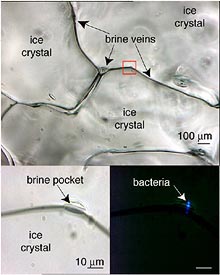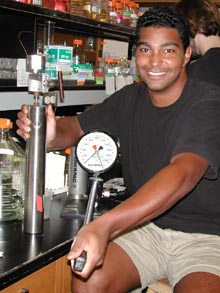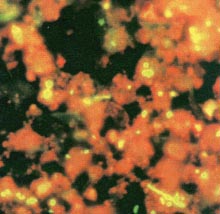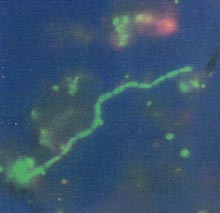
Sea-ice that appears solid to the eye and hand is deceptive. Within the ice matrix, on a scale relevant to microorganisms, tiny veins and pockets of briny fluid that house bacteria exist. (Adapted from Junge et al., 2001, Annals of Glaciology). Click image for larger view and expanded caption.
Novel Microorganisms from the Cold Deep Sea
Jody W. Deming
Professor, School of Oceanography
University of Washington in Seattle
By far the greatest portion of the world's ocean is dark, cold, and deep (about 1 km), yet we know little about the life forms that dwell there or how they survive below the sunlit, food-rich surface layer. At temperate and low latitudes, where most sea-going research takes place, the lighted surface layer is very warm, but in polar regions, even the shallowest waters approach the freezing point of seawater, and are often covered by a thick layer of ice (2 to 3 m).
In deep polar oceans, like the Arctic's Canada Basin, these frigid temperatures are compounded by elevated hydrostatic pressures, which can reach levels of 400 atmospheres or higher, depending on water depth. Organisms living under these conditions must also be adept at finding food or surviving long periods without it, because less than 10 percent (often much less) of the food produced through photosynthesis at the lighted surface ever reaches the sea floor, including phytoplankton adrift in the water or algae inhabiting the ice cover. Some food, however, will leak from the upper ocean to fuel the organisms of the deep, but usually in insufficient amounts to sustain the organisms.
In spite of the seeming severity of a place like the deep Canada Basin, we can predict the presence of invisible life forms—microorganisms no wider than 1 micrometer, uniquely adapted to darkness, cold, high pressure and a limited food supply. We already know that about 100,000 bacteria are present in a drop of seawater, and easily a billion can be found accumulated in each thimbleful of sediment on the sea floor. The challenge is to decipher which of these tiny organisms are alive and active in the deep sea, which ones are dormant, and which might possibly be brought into culture.

This high-magnification image, using transmission electron microscopy, shows 1-µm-sized bacteria inside a deep-sea mollusc that naturally concentrates particles from the surrounding seawater as it feeds. (Adapted from Deming et al., 1997, Microscopy Research and Technique.) Click image for larger view.
One of our greatest successes has been to return deep-sea samples recovered shipboard to simulated deep-sea conditions, after first giving the bacterial inhabitants some fresh food in the form of dissolved organic compounds. We can simulate deep-sea conditions using stainless steel pressure vessels, repressurized using a hydraulic hand pump, which can then be incubated at the cold temperatures of the original environment. Immersing the sealed, pressurized, sample-filled vessels into an ice-water bath in a picnic cooler will do the trick. Of course, we must conduct more laboratory work beyond the initial incubation period to obtain bacteria in pure culture, but the first steps taken shipboard are the critical ones for success.
Although seafloor sediments harbor the greatest densities of bacteria, the most active populations are those found in the guts of deep-dwelling animals. Many deep-sea pelagic and benthic animals, in the course of their feeding activities, naturally concentrate within their tissues a variety of organic particles. Their guts thus become rich in organic food and bacteria alike.

David Allen, graduate student at the University of Washington, happily displays a stainless steel pressure vessel and the hand pump that will be used to return samples of deep-sea bacteria to their natural conditions. Click image for larger view.
The bacteria within the gut release a variety of enzymes that work to degrade the food materials for the benefit of both the animal and the bacteria. By re-pressurizing material removed from the gut of a deep-dwelling animal, or trapped by the mucus webs released by specialized feeders known as larvaceans, we have the best chance of bringing into culture novel microorganisms adept at producing "extremophilic" enzymes functional in the cold at high pressures.
Other Arctic habitats that are prime candidates for yielding novel microorganisms or enzymes are associated with the ocean's sea-ice cover. Sea ice is also a natural concentrator of particles and organic materials. When the temperature drops low enough, the water in seawater freezes into solid ice-crystals, leaving the sea-salts, as well as any other particles, organics or organisms, to concentrate in tiny pockets of brine within the ice. (Please see figure at top of page.) These and other fluids associated with sea ice may yield potentially novel microorganisms that are uniquely adapted to high salt and the cold rather than high pressure. Surprisingly, some sea-ice bacteria that have already been obtained in culture are very closely related to bacteria from the deep sea. Let's see what cultures will result when sea-ice samples are studied in our shipboard simulators.

This high-magnification microscopic image shows yellow-stained bacteria, each one about 1 micrometer wide, colonizing sediment grains from the deep sea. Such images allow us to determine the number of bacteria in sediments (this sample has already been diluted 10,000-fold), but not which ones are active, since any intact cell containing DNA, whether it is active or dormant, will take up this stain. (Photo courtesy of Shelly Carpenter). Click image for larger view.

This high-magnification microscopic image shows other deep-sea sediment bacteria, this time stained with DAPI, a DNA-specific stain. Here we can deduce bacterial activity from the chain of cells, some of which have clearly reproduced (divided in half) but not yet separated from each other. (Photo courtesy of Shelly Carpenter). Click image for larger view.
Sign up for the Ocean Explorer E-mail Update List.


























